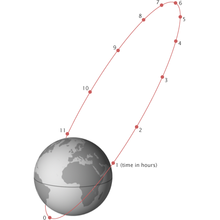Molnija (satellite)
Molnija, or Molniya ( Russian Молния for lightning , GRAY index: 11F67), is the name of Soviet and later Russian communications satellites that orbit the earth on eccentric HEO orbits , especially in Molnija orbit . The inclination is 63 °, the orbital time 718 minutes (approx. 12 hours). The perigee , a distance between 450 and 600 kilometers, lies over the southern hemisphere. In the apogee at a distance of 40,000 kilometers, the satellites move so slowly over the northern hemisphere in accordance with Kepler's laws that they are about eight hours above the horizon. Four satellites enable continuous data transmission even at high latitudes that geostationary satellites cannot. The satellites are used for both civil and military communications (a SECAM color television signal or 60 telephone channels or telegraph or fax transmission).
After numerous preliminary tests, the first Molnija satellite (Molnija-1) launched on April 23, 1965. The satellite was tested until October 1967 and with the launch of Molnija-1F, the Orbita ground stations and the system were also put into operation during this period officially declared operational. The satellites of this type consisted of a cylindrical, hermetically sealed and gas-filled device section with a conical closure, which contained the sensors and engines for position control. The energy supply is provided by six solar cell arms. On the outside of the cylinder there are cooling surfaces and a heating plate as well as two diametrically opposed antenna dishes, one of which served as a reserve. These have a transponder in the frequency range of 1.0 / 0.8 GHz with an output of 40 watts for television broadcasts and otherwise 14 watts. The satellites weighed around 1000 to 1200 kg (1.6 t at launch), were 4.4 m high and 1.4 m in diameter. The Molnija-2 satellites were developed types that received in the frequency range 3.4-3.9 GHz and transmitted in the range from 5.725 to 6.225 GHz. They had a similar configuration with enlarged solar cell arms and transmitted video signals with a bandwidth of 6 MHz and an audio channel of 10 kHz mono or 6 kHz stereo, as well as an audio / data channel frequency-modulated with 150 kHz in parallel to the video signal. The first Molnija-3 satellite was launched on November 22, 1974. These were used, among other things, for direct connections between Moscow and Washington. Four Molnija-3K satellites have been in space since 1997. The launch of another satellite in July 2005 with a Molnija-M launcher failed.
Versions
So far, the Molnija satellites have been launched in five different versions.
- Molnija-1 (from 1964)
- Molnija-1T (from 1970)
- Molnija-2 (from 1971)
- Molnija-3 (in service from 1974)
- Molnija-3K (in use from 1997)
The successor to all Molnija versions still in use is a new generation of satellites called Meridian . The first launch took place on December 24, 2006.
Web links
- Information about the Molniya project. FAS (English)


